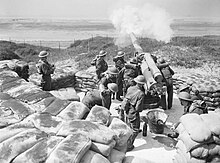
BL 4-inch Mk IX naval gun

| Ordnance BL 4-inch Mk IX gun | |
|---|---|
 On Flower-class corvette HMCS Calgary in World War II | |
| Type | Naval gun |
| Service history | |
| In service | 1917–1945 |
| Used by |
|
| Wars | World War I World War II |
| Production history | |
| No. built | 2,382[1] |
| Specifications | |
| Mass | 2 tons barrel & breech[2] |
| Barrel length | 180 inches (4.572 m) bore (45 calibres) |
| Shell | 31 pounds (14.1 kg) |
| Calibre | 4 inches (101.6 mm) |
| Breech | Welin interrupted screw |
| Elevation | -10 degrees to +30 degrees[3] |
| Rate of fire | 10-12 rpm[3] |
| Muzzle velocity | 800 metres per second (2,600 ft/s)[2] |
| Maximum firing range | 12,660 metres (13,850 yd)[2] |
The BL 4-inch Mk IX naval gun[note 1] was a British medium-velocity naval gun introduced in 1917 as secondary armament on the Renown-class battlecruisers and Glorious-class "large light cruisers", but which served most notably as the main armament on Flower-class corvettes throughout World War II.

History
World War I

The gun was based on the barrel of the QF 4-inch Mk V and the breech mechanism of the BL 4-inch Mk VIII[4] and was first introduced in World War I on capital ships as secondary armament in triple-gun mountings, intended to provide rapid concentrated fire. This turned out to be unworkable in practice. Jane's Fighting Ships of 1919 commented, "4-inch triples are clumsy and not liked. They are not mounted in one sleeve; have separate breech mechanism, a gun crew of 23 to each triple".[5] Guns were thereafter used in single-gun mountings, typically on smaller ships as the main armament.

World War II


In World War II, the gun was employed on many small warships such as Flower-class corvettes and minesweepers, primarily for action against surfaced submarines.

This was the last BL 4 inch gun in British service: all subsequent guns have used charges in metal cartridges "QF". It was succeeded on new small warships built in World War II by the QF 4-inch Mk XIX gun which fired a slightly heavier shell at much lower velocity and had a high-angle mounting which added anti-aircraft capability.

Surviving examples
- On board HMCS Sackville, the last surviving Flower-class corvette, at Halifax, Nova Scotia, Canada
- A gun at the entrance to the marina in Hull, UK
- A gun at Port Isaac, Cornwall, UK
- Leith Harbour, South Georgia.
See also
Notes
- ^ Mk IX = Mark 9. Britain used Roman numerals to denote Marks (models) of ordnance until after World War II. Mark IX indicates this was the ninth model of BL 4-inch gun.
References
- ^ Campbell, Naval Weapons of WWII, pp.42-43.
- ^ a b Campbell, Naval Weapons of WWII, p.38.
- ^ DiGiulian
- ^ "Jane's Fighting Ships 1919, page 62". Archived from the original on 6 October 2008. Retrieved 18 December 2008.
Bibliography
- Tony DiGiulian, British 4"/45 (10.2 cm) BL Marks IX and X
- Campbell, John (1985). Naval Weapons of World War Two. Naval Institute Press. ISBN 0-87021-459-4.
See what we do next...
OR
By submitting your email or phone number, you're giving mschf permission to send you email and/or recurring marketing texts. Data rates may apply. Text stop to cancel, help for help.
Success: You're subscribed now !
